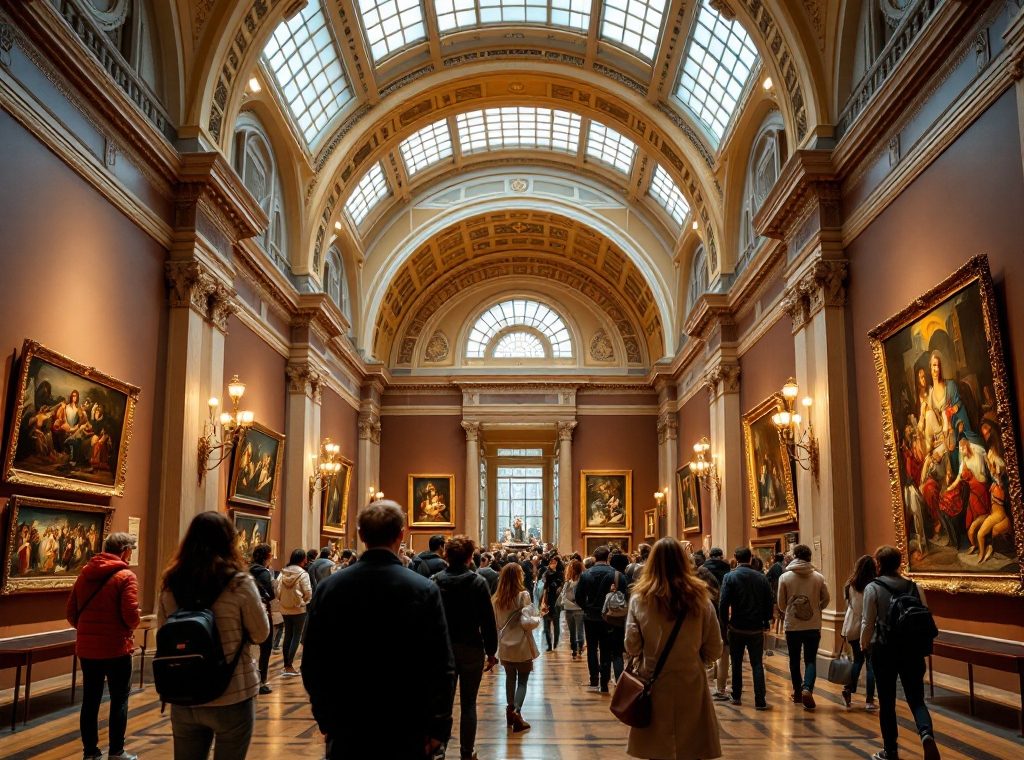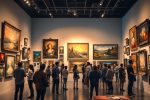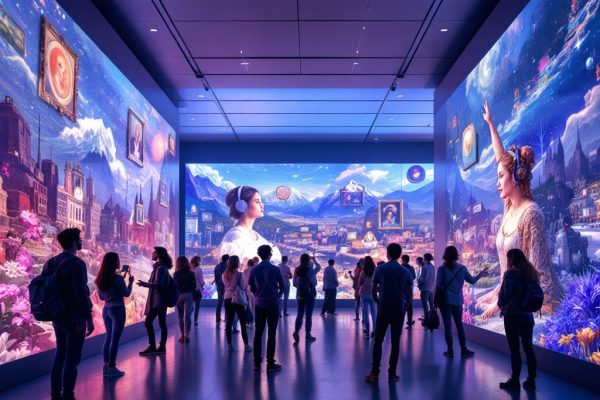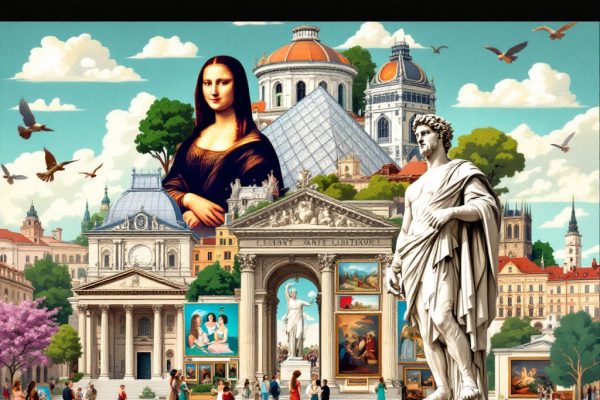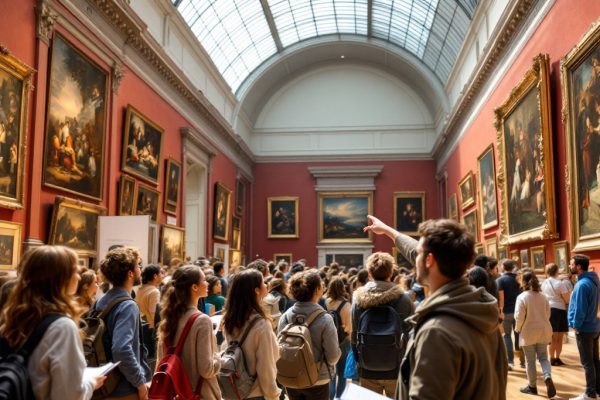The Most Interesting National Galleries of Art Around the World
Journey through the world’s most captivating art! Discover masterpieces by da Vinci and Rembrandt at iconic institutions like the Louvre and Prado. Explore diverse collections, from Renaissance treasures to modern marvels. Learn how national galleries preserve cultural heritage and enrich our understanding of art. Start exploring today!
Important information

- National galleries preserve a nation’s art and offer public access to diverse collections and exhibitions.
- World-renowned galleries like the Louvre, Prado, and British Museum house iconic masterpieces and artifacts.
- The National Gallery of Art in Washington, D.C., features a vast collection of European and American art, spanning from the Middle Ages to contemporary works.
- Guided tours and educational resources enhance the gallery experience by providing insights into art history, techniques, and cultural contexts.
- Planning your visit, including online ticket purchase and research, ensures a more fulfilling experience.
The Most Interesting National Galleries of Art Around the World
World-renowned art museums like the Louvre in Paris and the Prado in Madrid house impressive collections that have shaped art history. These museums showcase masterpieces from various eras and movements, attracting millions of visitors with their stunning architecture.
- Louvre Museum (Paris): known for its extensive collection and iconic architecture.
- Prado Museum (Madrid): features a significant collection of European art.
Beyond these iconic institutions, other national galleries offer unique perspectives on art and culture.
- National Gallery of Canada: champions Canadian and Indigenous art.
- National Gallery of Art (Washington, D.C.): focuses on European and American works.
- British Museum (London): houses a global collection of art and artifacts.
- Vatican Museums: showcases iconic pieces, including the Sistine Chapel.
What Defines a National Gallery of Art?
A national gallery of art safeguards a nation’s artistic heritage. It serves as a crucial public resource, offering access to extensive collections and engaging exhibitions. Alongside dynamic educational initiatives, these galleries showcase important artworks from various periods and styles, reflecting the nation’s cultural identity and artistic accomplishments. Through research and scholarship, they cultivate art appreciation, enriching public understanding and recognition of art’s value.
The Impact of National Galleries on Art and Culture
National galleries champion art and culture through exhibitions, global partnerships, and extensive research. They showcase artists’ work, preserving our shared heritage while educating the public. These vital institutions foster artistic exchange and drive innovation, making art accessible to all.
Exploring Iconic National Galleries and Their Masterpieces
- The Louvre in Paris is renowned for iconic works like the Mona Lisa and Venus de Milo.
- London’s British Museum houses a remarkably diverse collection of global artifacts.
- New York’s Metropolitan Museum of Art boasts a vast collection spanning various cultures and time periods.
- The Vatican Museums are home to the Sistine Chapel and an extensive collection of religious art.
- Art lovers flock to Florence’s Uffizi Gallery to admire Renaissance masterpieces.
- In Madrid, the Prado Museum showcases a significant Spanish art collection, including works by Goya and Velázquez.
- Dutch Masters like Rembrandt and Vermeer are featured at Amsterdam’s Rijksmuseum.
- Australia’s National Gallery in Canberra focuses on Australian and Indigenous art.
- Tokyo’s National Museum of Modern Art offers a comprehensive collection of 20th and 21st-century pieces.
- London’s National Portrait Gallery celebrates prominent figures in British history through its portrait collection.
The Louvre Museum (Paris, France)
The Louvre Museum in Paris houses an impressive collection of art, including masterpieces like the Mona Lisa and Venus de Milo. Its collection comprises over 380,000 objects from various civilizations and historical periods. The museum’s iconic glass pyramid serves as a grand entrance. Originally built as a fortress in the 12th century, the Louvre later became a royal palace before opening as a public museum in 1793. Today, it represents a blend of rich history and artistic brilliance.
The British Museum (London, England)
Explore the British Museum’s unparalleled collection spanning diverse cultures and historical eras. Discover iconic artifacts like the Rosetta Stone and Elgin Marbles alongside a vast array of global treasures. Enjoy free admission and engaging programs that offer deeper insights into human history. Enrich your London visit with an inspiring experience at the British Museum.
The Metropolitan Museum of Art (New York, USA)
The Metropolitan Museum of Art in New York City presents a vast collection encompassing diverse cultures and centuries. Similar to the National Gallery of Art, it offers a richly immersive experience engaging all the senses.
The Vatican Museums (Vatican City)
The Vatican Museums house an astounding collection of masterpieces, including Michelangelo’s breathtaking Sistine Chapel ceiling and the exquisite Raphael Rooms. From ancient sculptures and intricate tapestries to significant religious artifacts, the vast holdings reflect both the Church’s rich history and its enduring patronage of the arts.
The Uffizi Gallery (Florence, Italy)
Florence, Italy, is home to the renowned Uffizi Gallery, boasting an exceptional collection of Renaissance masterpieces. Visitors can admire iconic works by Botticelli, Michelangelo, and Leonardo da Vinci within its historic walls. Originally designed for Florentine magistrates, this unique setting enhances the experience of exploring the gallery’s vast collection, tracing the evolution of art from the Middle Ages to the Modern era.
The Prado Museum (Madrid, Spain)
Visit the Prado Museum in Madrid, home to a remarkable collection of European art, especially Spanish masterpieces. Don’t miss Velázquez’s iconic *Las Meninas* and Goya’s powerful *The Third of May 1808*. The museum also features notable Italian and Flemish works, making it an essential destination for art lovers.
The Rijksmuseum (Amsterdam, Netherlands)
The Rijksmuseum in Amsterdam offers a captivating journey through Dutch art and history. Its vast collection spans centuries, showcasing masterpieces from the Golden Age, including Rembrandt’s “The Night Watch” and Vermeer’s “The Milkmaid.” The museum also features decorative arts and historical artifacts, providing a comprehensive view of Dutch culture. Interactive exhibits and educational resources enrich the visitor experience.
National Gallery of Australia (Canberra, Australia)
Canberra’s National Gallery of Australia and Washington, D.C.’s National Gallery of Art both hold diverse collections spanning various cultures and eras. Both institutions prioritize accessibility, welcoming a broad range of visitors.
National Museum of Modern Art (Tokyo, Japan)
Tokyo’s National Museum of Modern Art celebrates modern and contemporary art, much like the National Gallery of Art’s modern collection.
While both institutions highlight modern artistic narratives, they offer these perspectives from opposite sides of the globe.
National Portrait Gallery (London, England)
The National Portrait Gallery in London presents a compelling exploration of British history and culture through captivating portraits of its most influential figures. The collection ranges from pivotal historical personalities to contemporary icons, illuminating the lives of those who have shaped the nation. These portraits offer a unique perspective on British culture, making the gallery a must-visit for anyone interested in understanding Britain’s rich heritage.
The National Gallery of Art, Washington, D.C.: A Cultural Treasure
The National Gallery of Art in Washington, D.C. houses an extensive collection of Western art, spanning from the Middle Ages to the present day. The collection encompasses European and American paintings, sculptures, and various other art forms. It preserves artistic heritage and makes it accessible to all.
West Building
Displays historic European art.
East Building
Showcases modern and contemporary works.
The Gallery’s masterpieces include works by renowned artists such as da Vinci, Rembrandt, Monet, and Van Gogh. This historically significant collection represents diverse artistic movements and provides a comprehensive overview of art history. The National Gallery offers interactive exhibits and educational resources, providing insights into artistic techniques and historical contexts. These programs cater to a wide range of audiences, from children to scholars. Expert-led guided tours provide in-depth explorations of both the permanent collection and special exhibitions. The Gallery attracts visitors from around the globe. Through collaborations with international art institutions, the Gallery facilitates knowledge exchange and promotes shared cultural heritage. Joint exhibitions and research projects broaden access to art and foster intercultural understanding.
Art Collection and Historical Significance
The National Gallery of Art in Washington, D.C. boasts a vast collection spanning diverse historical periods and artistic movements. From European paintings to American sculptures, the Gallery’s holdings include masterpieces by renowned artists such as Leonardo da Vinci, Rembrandt, and Monet. This historically significant institution not only preserves these works, but also showcases the evolution of art and the cultural exchange across different eras, offering visitors a rich exploration of art history.
Interactive Exhibits and Educational Resources
The National Gallery of Art’s interactive exhibits help visitors connect with the art, offering deeper engagement and a richer experience. Educational resources further enhance understanding and appreciation.
Guided Tours and Art Tourism
Guided tours at the National Gallery of Art enrich your visit by offering valuable insights and context, deepening your understanding and promoting art tourism and cultural engagement. They enhance the experience and provide a richer appreciation of the art.
Collaborations with Global Art Institutions
The National Gallery of Art partners with international art institutions, fostering a dynamic exchange of artistic ideas and research. This collaboration leads to:
- joint exhibitions,
- scholarly exchanges, and
- collaborative conservation projects.
These initiatives enrich the global art community, strengthen international ties, and broaden our understanding and appreciation of art, making a significant impact worldwide.
Enhancing Your Visit to National Galleries
Planning your art gallery visit involves a few key steps:
Research the gallery online. Explore their collection, special exhibits, hours, admission fees, and any scheduled events.
Purchase tickets online in advance. This will allow you to bypass the queue and save time.
Prepare for your visit. Wear comfortable shoes for extensive walking and carry a small bag for essentials.
Enhancing Your Gallery Experience
Immerse yourself in the art by exploring at your own pace. Observe details like brushstrokes and composition. Read artwork descriptions and consider the cultural context to interpret the artist’s message.
For a deeper dive:
- Consider a guided tour led by knowledgeable scholars for valuable insights.
- Attend lectures focusing on specific art movements or individual artists.
- Engage in discussions and ask questions to further your appreciation.
- Supplement your visit with books and articles about artists or periods that interest you.
Tips for a Fulfilling Visit
Maximize your visit with these tips:
- Allocate sufficient time to fully appreciate the artwork.
- Take notes or sketch your favorite pieces.
- Visit the gallery shop for books, prints, and souvenirs.
- Reflect on your experience and share your insights with others.
Planning Your Trip: Tips for Art Enthusiasts
Enhance your cultural experience by visiting world-renowned art galleries. Explore diverse collections and captivating exhibits at the Louvre, British Museum, or National Gallery of Australia. Each gallery offers engaging educational programs to enrich your visit.
Louvre Museum
Immerse yourself in Renaissance masterpieces and Parisian life. After exploring the Louvre, enjoy a meal at a traditional bistro. Due to its popularity, booking your visit in advance is essential.
British Museum
Journey through world history with the museum’s extensive collection. Plan your visit accordingly to make the most of your time.
National Gallery of Australia
Discover a remarkable collection of Australian and Indigenous art. This gallery is a must-see for art lovers.
Plan Your Visit
Check each gallery’s website for hours, admission fees, and tour options. Advance booking is highly recommended, especially during peak seasons. Enhance your experience by exploring nearby accommodations, dining, and local attractions.
How to Engage with Art Exhibitions and Cultural Narratives
Explore art exhibitions and immerse yourself in the artwork. Analyze each piece, pondering its meaning and the artist’s intention. Consider the historical context and cultural influences that shaped the work. Engage by asking questions and participating in discussions, connecting the artwork’s narrative to your own experiences. This approach fosters a deeper appreciation and understanding of art. Institutions like The National Gallery of Art champion this interactive engagement, helping visitors forge personal connections with the art they encounter.
Understanding Art Through Guided Tours and Art Scholars
Guided tours of national galleries significantly enhance the visitor experience. Art scholars provide insightful analysis and context, fostering a deeper appreciation for the artwork.
The National Gallery of Art, for instance, offers these enriching tours, increasing engagement with its impressive collection. Visitors can learn about an artist’s life and the historical context of a masterpiece. Even exploring independently, the gallery remains a source of inspiration.

